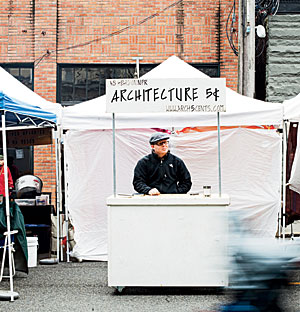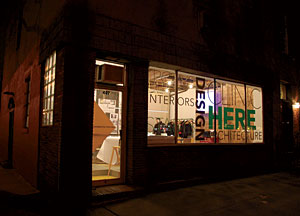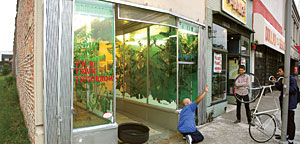Three recent projects attract clients by offering design services in unconventional locations.
Design.Starts.Here looked like any other architecture studio: whiteboards covering the walls, a gaggle of stylish stacking chairs, and what one designer called “a really great conference table.” But there was one big difference: You could see it.



Three architects at established firms share how they land new projects when work is scarce.
While most architecture offices sit high above the fray behind tastefully marked doors, Design.Starts.Here was out in the open, occupying a glass-walled storefront on a busy intersection in New York City’s West Village. The designers behind the temporary office decided to go where the work is, offering new kinds of projects to new kinds of customers: cheap, quick designs targeted at middle-class homeowners. And they’re not alone. Around the country, nimble architects are marketing to the masses — saving their bottom lines, but shaking the foundation of an already rattled industry.
“It was a hard year,” says Edward Gavagan of PraxisNYC, one of the designers behind Design.Starts.Here. “Our bread and butter was high-end residential design, and we got hit bad.” But after Gavagan’s friend Poonam Khanna of Re:Design Architecture + Interiors saw a temporary “pop-up” store — an outpost of mega-retailer Target open for the holiday shopping season — and Gavagan met someone with an unused storefront, they called their friends at Basil Walter Architects and 3-By Architecture and decided to try a new strategy.
Design.Starts.Here opened in early December with little fanfare, says Gavagan. “We just had a sandwich board that said ‘free design consultations.’ ” But sure enough, “People would poke their heads in, say, ‘I’ll be right back!’ Run home, take some pictures, and come back saying, ‘Help! I hate my kitchen.’ ” For just over a week, Design.Starts.Here offered free consultations and sketches as well as a menu of fixed-fee, basic services, from a $250 one-hour, on-site consultation to a $10,000 preconstruction package, including site visits, plans, and preliminary budgets. Keeping services clear and transparent drew in everyone from the 13-year-old girl who wanted to redecorate her bedroom to a Long Island woman trying to decide what to do with her living room. These were people, the designers stressed, who never would have hired an architect had they not seen the storefront.
“Architecture seems unattainable,” says Khanna. “We wanted to make it less intimidating.” Of course, by convincing a new audience they need architects, Khanna and her coworkers were creating customers. But they balked at calling the pop-up store a business-generator. “That truly wasn’t the idea,” Khanna said. “Fundamentally, it was an educational tool.”
Working out of their own storefront just outside of Detroit on Hamtramck, Michigan’s main drag, Design99’s Mitch Cope and Gina Reichert had a similarly high-minded agenda. “Our plan was to reeducate people on why they need architects,” Cope says. The couple left their jobs — he as a curator, she as an architect with Gensler — and started offering $99 consultations to their neighbors. “Detroit needs a lot of design help — it’s all old housing stock, but people are trying to rethink how they’re living.” One customer, for example, was moving out of Detroit and into Hamtramck with his schizophrenic brother. He was trying to renovate his new house so that both of them could live safely and comfortably together. “He would never in a million years have hired a designer if he hadn’t come across us,” Cope says. Not only did Design99 take on the renovation, the client has since hired them again to design a garden.
“If you walk down the street and ask everyone you see, ‘Do you need help with your home?’ Somebody’s going to say yes. And those people will be jobs,” says John Morefield. After getting laid off twice in one year, Morefield set up a booth in a Seattle farmer’s market advertising design advice for five cents. It made him the poster child for marketing architecture to the middle-class masses, but it also made him a target.
Many accused Morefield of misrepresenting himself as a licensed architect — he is currently going through the registration process, though he works with a registered architect and is legally able to practice residential design in Washington without an architecture license. More damning critics, though, argue that Morefield and designers like him are cheapening the profession.
Morefield is quick to point out that he doesn’t offer discount services. After the initial five-cent conversation, he says, “I charge legitimate rates. You can’t get a house designed for a pocket full of nickels.” But nor can you open up a new market of customers with an unaffordable product. Architecture has been elitist for too long, he says. Maybe it should get cheaper: “Middle America deserves good design too.”
“You can see this play out in the fashion industry,” says Rob Walker, who writes the “Consumed” column on marketing for The New York Times Magazine. He cites couture label Comme des Garçons’s collaboration on a line with budget retailer H&M, and Calvin Klein’s licensing program that sells its name to other manufacturers. Once exclusive, now the Calvin Klein label is cheap — but it’s also ubiquitous. “The thing is,” he says, “once you become associated with a bargain deal, there’s no going back.”
Major firms used to major clients and clinging to prerecession rates might squirm at going cheap, even if it’s just for a consultation, but for the pioneers of this new market, the grass is greener. “I’ve been employed since the day I set up the booth,” Morefield says. Overrun with work, Cope and Reichert recently closed the Design99 storefront to focus on a few major home renovations as well as a project with the Detroit Institute of Arts. Design.Starts.Here is following up on a number of projects initiated in December and hopes to open another “pop-up” store soon. For them, it’s a welcome change of pace. “As an architect, you don’t get to see that many people,” Khanna says. “And a stream of 100 percent happy people walking out the door … well, that’s even rarer.”

Post a comment to this article
Report Abusive Comment